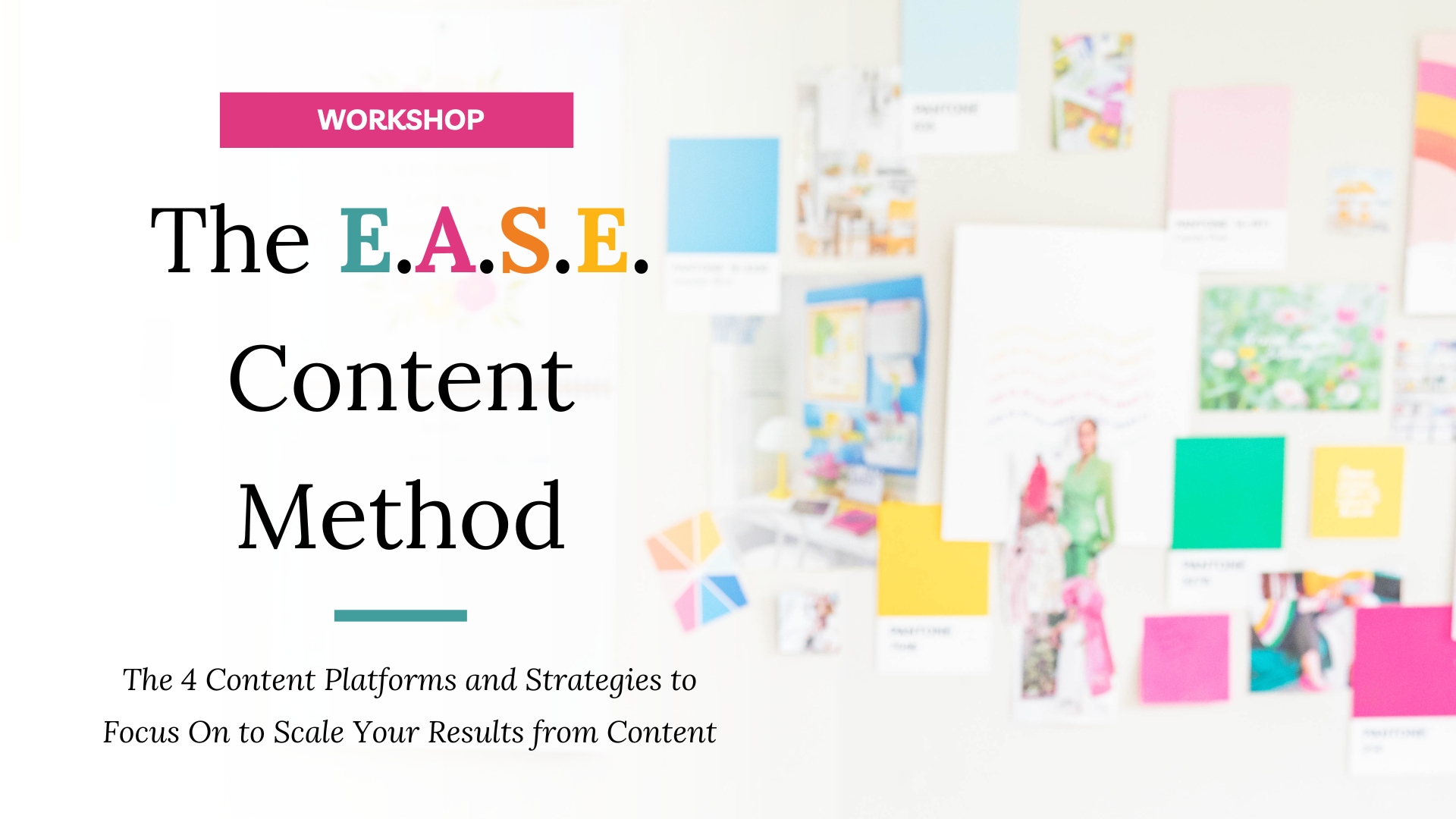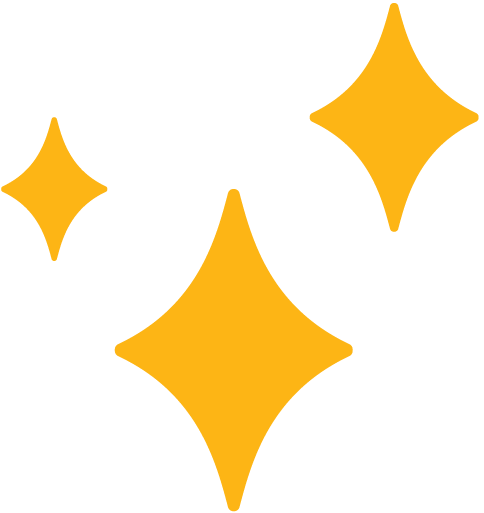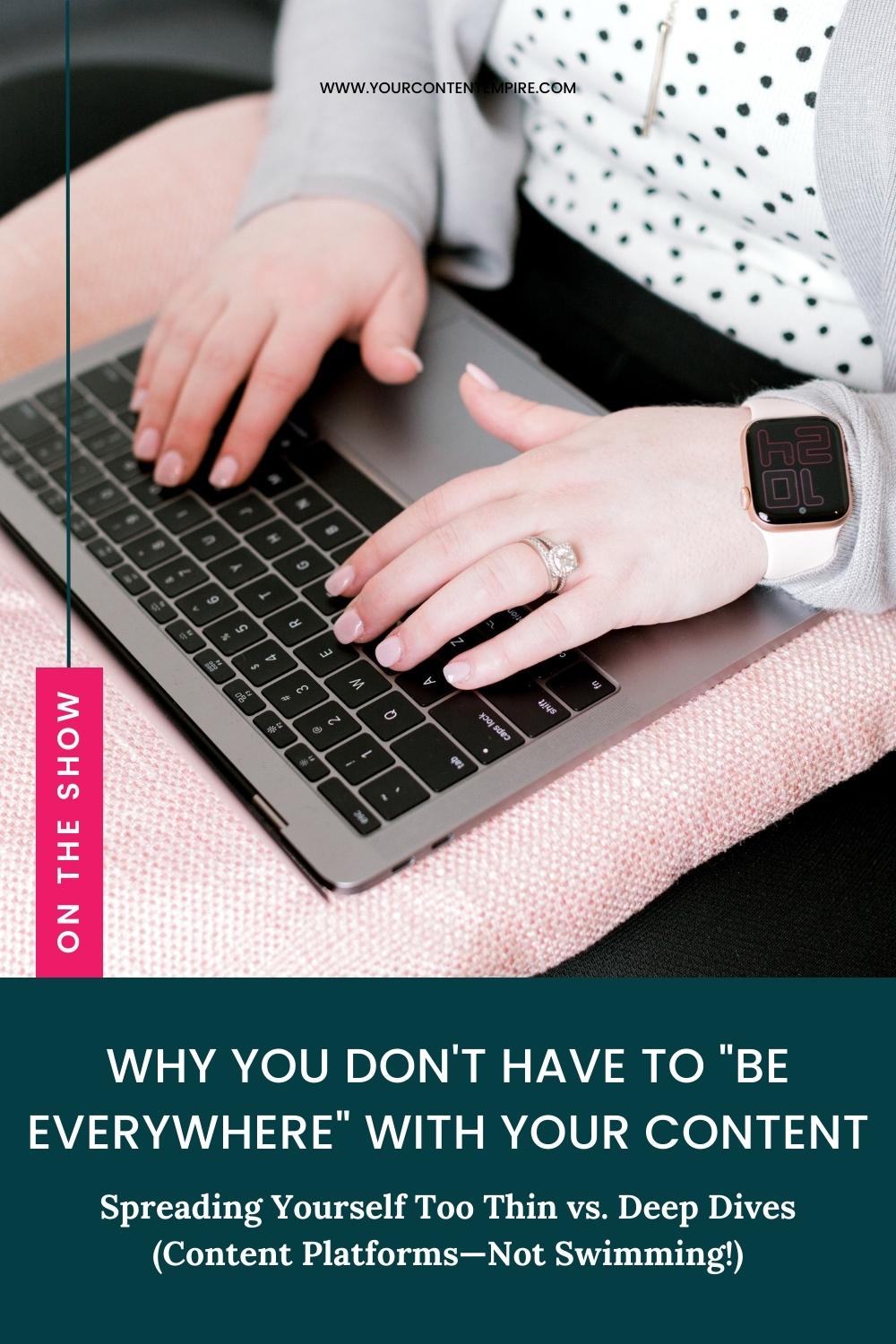Drowning in a sea of many many platforms and strategies but feel like you’re getting nowhere?
Check out the first episode of the Content Coffee Break podcast for a fresh, no-nonsense strategy. (Spoiler: Less is actually more!)
Here’s a preview of what I’m covering…
- Picking Your Platform Playground: Go big on a few platforms instead of dabbling everywhere. Focus over frenzy!
- Get More Out of Less Time: Make the most of the little marketing time you've got. Delegate, systemize, and don't sweat the small stuff. (It's like meal prepping but for content.)
- Active vs. Amplification Platforms: Know where you're spending lots of time (active) and where you're just posting and ghosting (amplification).
Create a Cohesive Content Strategy Leveraging The 4 Essential Content Platforms and Strategies:
Get instant access to my E.A.S.E. Content Strategy Workshop where you'll learn the 4 content platforms and strategies to focus on to scale your results and sales from content. Plus you'll get my exclusive EASE Content Planning Spreadsheet for FREE ↓

FULL TRANSCRIPT:
Welcome to the first, like, official episode of the Content Coffee Break podcast. I am so excited to have you here and especially to kick things off with this topic in particular, which is: you don't have to be everywhere in order to be seen. In fact, there's a much better way to make sure that your strategy is balanced and moving you forward both in terms of nurturing your existing people and getting you in front of new people, thus growing your email list, your community, and your audience. Rather than feeling pulled in so many different directions and feeling like you're spinning your wheels.
I recently came back from an epic trip to Italy and Switzerland. I've been planning this trip for three years. We've called it our “Switzaly trip” in our heads as we were planning it. My husband and I have been thinking about this ever since I was young. I think I was around 21 or 22 when I watched the movie “Under the Tuscan Sun” with Diane Lane and Sandra Oh. It shows off Tuscany and Italy, and I just fell in love with the idea of going to Tuscany. Let me tell you, it lived up to expectations. But the reason I bring this up is that being on that trip, especially since it's been a few years since I traveled (like many people took a break during the pandemic), reminded me of why I started my business and what I love most about working in an online business. This means I can work from anywhere.
On the trip, I would wake up early. I'm an early riser anyways. My husband is not; he likes to sleep. So, I would wake up early, work for a couple of hours (since I was so far ahead of everyone else back home in terms of hours), and then go off to sightsee. I could be fully present and immersed in this trip of a lifetime. It brought me back to the reason I started that business.
The reason I started my business was so that I could travel. I didn't start traveling until my thirties. I went to school, did all the things, and had zero money for traveling when I was younger. I've always had this thirst to see all the places and do all the things. But through a normal nine-to-five, and getting into this through consulting and public service in communications, those two weeks a year of vacation were not going to cut it for the wanderlust that I had, which had been brewing my entire life but wasn't realized until my thirties. That was a huge motivation for me in starting the business: having that freedom and being able to fit my work around my life, not my life around my work. This relates to today's topic because what I see happening for myself, for my clients, for people that I coach, is that we started this business with some degree of freedom, and that was the reason why. But, through the hustle and bustle and the myriad of ideas, our to-do lists grow really long. We may not have a boss anymore telling us what we should be doing, but in some ways, we have become our own bosses. This isn't necessarily a bad thing. However, many of us get further and further away from that freedom that we started our business for. We have to start questioning: does the stuff that I'm working on actually matter and move the needle forward? Or am I just doing this because it's what everyone else is doing or what I think I'm supposed to be doing? You can start to see the parallels with some of the frustrations you might have had working in a nine-to-five, rather than jumping straight into business. There are these internal expectations that you are putting on yourself. For me, this trip was a good re-centering and a reminder of the freedom I started my business for, and I knew this topic had to be the first thing we talked about.
To bring it back to the topic, there is a pervasive myth that I see pretty much everywhere, in different online circles and even in my in-person business networking groups. That is, you have to be everywhere in order to be seen. Most business owners make content a lot more difficult and complicated than it has to be by buying into this myth. It's something that happens with me from time to time. I see someone excelling on a particular platform, and suddenly I get the “shiny object syndrome”. I start thinking, “Do I need to be there as well?” Usually, I'm able to catch myself, but no one is immune to that shiny object syndrome. One of the reasons we feel pressure to be everywhere is because we perceive our competitors, or peers in the industry if you prefer that term, as being everywhere. You might be doing just fine on Instagram as your attraction platform. But one day you're on Pinterest, and you see pin after pin targeted at your customers, helping them solve problems. Suddenly, you're spiraling because you haven't been focusing on Pinterest at all. Have you been making a massive mistake the whole time by not being there? This spiral isn't necessarily about Pinterest or Instagram; it can be about any platform or strategy. It usually comes down to FOMO (fear of missing out) and a bit of a scarcity mindset. There are only so many clients to go around, and so you feel you need to be the one that gets in front of them. It's FOMO because when you see other people using a particular platform or strategy, you think you're missing out on an opportunity and might feel some kind of regret or guilt. It's a scarcity mindset because you're focusing on your territory being infringed upon, whether it's audience or expertise, and are worried about your audience being in limited supply. Instead of embracing the truth that there are more than enough clients, customers, opportunities, and interest for everyone to grow, the more time you spend focusing on your peers or competitors, the less time you are able to spend focusing on those that actually matter: your current and future customers.
Okay, let's take a few steps back here. I think I haven't dropped a major piece of the puzzle. I'm hosting a workshop in a few weeks called the EASE Content Strategy Method. This is something that I have been teaching in my courses, as well as my individual coaching. It's also something that comes up in our funnel launch plans over at the agency. I mentioned an attraction platform being either your Instagram or Pinterest account. But the EASE Content Strategy Method works because it helps you increase your content ROI by simplifying your approach to content. It leverages the Pareto Principle or the 80/20 rule to get you focused on what I believe are the four most essential content platforms that generate 80% of your results, sales, and growth opportunities. Instead of staying stuck in the weeds and trying to manage and grow the 10, or actually 13 on average, content channels that most businesses focus on, it really simplifies down to those four. Those four don't represent a specific channel, like it has to be Instagram or Pinterest. They represent the four different types of content platforms and strategies that I think every business owner should include in their strategies. And you don't need to be doing multiples of these either. The letters E-A-S-E stand for: an Expertise platform, where you establish your expertise (usually in the form of blogging with the only real rule being that it has a home on your website); an Attraction platform,
which is about what you're doing to get in front of new people; a Selling strategy or platform, which could be quarterly launches or an evergreen sales model or a combination; and an Engagement platform, which is about what you're doing to engage with your existing community.
The two that we're focused on today are the Attraction platform and the Engagement platform. We'll be talking more about these in the coming weeks as well on the Content Coffee Break. Attraction refers to the platform where you're getting in front of new people. You don't need to have multiple attraction platforms that you're working on at any given time. My approach is that you focus on one for 30 to 90 days, get it systemized, get it delegated, or decide that it's not going to work for you and move onto something else. Then you can layer on something else, but not feel like you're trying to grow and focus and establish roots on multiple types of these different platforms at the same time. Then we have the Engagement platform, which fosters two-way conversations. We want to prioritize something that your existing people are on. You can publish content there, but more importantly, you can be having those conversations.
So, why is less more? Another thing that takes up time is believing that you have to be active and showing up on multiple platforms at the same time. There truly is such a thing as spreading yourself too thin, especially when it comes to picking platforms. And the fact is that less is more when it comes to platforms, and here's why. First, it takes time to succeed on any given platform, especially in the building-up phase. Let's say you have one hour a day for marketing. You could spend that hour on one to two platforms, responding and engaging, creating new content, and do pretty well. But if you're focused on five different platforms, that's only 12 minutes per platform if you divide it up equally. You're going to make a lot less impact with each platform that you add on because, like everyone, your time is a limited resource. So this is about being more intentional with the time investments that you make.
An example of this would be Dan Henry, an entrepreneur who wrote the book “Digital Millionaire Secrets”. He talks about this idea of the Circle of Focus. If you think of your focus, time, or energy as one big circle or pie (if you've got a sweet tooth like me) and you focus on just one thing, 100% of your pie is going to be focused on that one thing. Success is basically inevitable. But if you start divvying up that pie among more priorities or platforms, you start spending 50%, 25%, or less of your time on each thing. Have you ever heard of someone succeeding in something when they're only giving it 5%? You might counter with, “I'm not about that hustle life.” And I'd say, “Me neither.” This isn't about doing only one thing all the time, but it is about getting more mileage out of the time you have dedicated for content and marketing. Think of your time blocks as individual circles of focus and ask yourself how many pieces of pie you want to break this up into, especially when that means diluting the results you're going to see in each area.
Alright, so you might be wondering, how do you go from acknowledging that less is more when it comes to content, to being okay with being in fewer places when FOMO or comparison situations arise? I have a few questions for you to consider in a second, but first, one of the things that has made a big difference in my business is distinguishing between active platforms and amplification platforms. This means that I might be intentionally focused on just two platforms: one attraction platform for getting in front of new people and another for engaging with my existing audience, which I call engagement platforms. But I'll still be publishing posts on other platforms, possibly. For example, right now my engagement platform of choice is Instagram, and my attraction platform of choice is Pinterest. My team and I are actively spending time on each of these places for the foreseeable future. But we're still publishing on our Facebook page and Facebook group in order to amplify our content easily, without spending a lot of time doing it.
Another thing that's been really helpful is remembering that once you've done the work to build up a platform and you've established roots there, it requires a lot less energy and time to maintain, especially if you've focused on systems. Newton's first law says an object in motion tends to stay in motion. So you could focus on just two platforms for 90 days, getting set up, creating templates, checklists, systemizing everything, and gaining momentum. Then, once you've finished that 90 days, you can either easily automate it or outsource it while you turn your focus onto other platforms.
So for this week, here are some questions for you to consider:
1. How many platforms are you currently trying to show up on actively?
2. How much time do you have available for content or marketing per day or per week?
3. How do you want to divvy up that circle of focus and that time?
Come and share your answers over on Instagram. You can tag us @YourContentEmpire or send me a message. I'd love to know your answers to these questions and hear your thoughts. Just a reminder to sign up for our EASE Content Strategy Method at YourContentEmpire.com/EASE. We are going to be talking more in-depth about these strategies and how to apply this simplified, but better results, strategy for your content and marketing. Thank you so much for joining me, and I will chat with you next week.
Ready to Implement?
Get instant access to my E.A.S.E. Content Strategy Workshop plus get my exclusive EASE Content Planning Spreadsheet for FREE ↓














